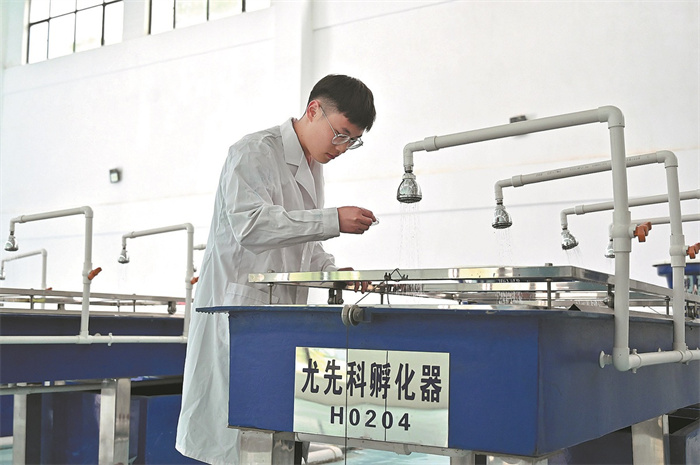Conservation protects fish stocks in Guangxi

A worker checks the hatching of fish eggs at a stocking station at Datengxia in Guiping. YU JING/CHINA NEWS SERVICE
Fish ladders
A team of over 20 has been hard at work since February, monitoring Datengxia's two giant fish ladders to make sure that fish are migrating through them smoothly.
For nine months, the monitoring is being conducted weekly in six different ways, including implanting tracking tags, catching and releasing fish sample sets and video monitoring.
"In the case of big variations in water levels and flows, the monitoring will be further intensified," said Zhou Jiawei, deputy head of the Datengxia company's monitoring department, adding that the efforts aim to figure out how these variations will affect the operation of the fish ladders.
According to Zhou, since the monitoring started about three years ago on the fish ladder that runs through the project's auxiliary dam, 66 species of fish have been recorded.
While it's hard to get an annual total, monitors have found an increase in the number of fish that manage to go through the ladder on an annual basis, he noted.
Stretching for 5.4 km, the fish ladder on the auxiliary dam is the country's longest fish ladder that mimics the natural watercourse, according to the Datengxia company.
Dotted with artificial lakes and wetlands, the fish ladder has a lot of twists and turns with a large degree of variability in depth. It has two lanes, with one specifically designed for the flood season.
The velocity of water in the fish ladder, which can range from 0.35 to 1.2 cubic meters per second, and its depth are set based on the characteristics of the main species of fish in the river section and tests the company conducted on the swimming capabilities of these species.
Zhou said the monitoring on the fish ladder of the main dam, which began in September, has so far recorded 30 fish species.
Huang Jun, chief engineer at the Datengxia company, said it lowers the water levels in the reservoir each year from April to September to create favorable conditions for fish to spawn upstream.
Fish that lay drifting eggs usually spawn from June to July. Aside from ensuring the spawning grounds of such fish are not inundated, low water levels in the reservoir help create the hydrologic conditions suitable for them to spawn, he said.
Li Guoliang, head of operations management at the Datengxia company's fish conservation center, said the company has released 12 million fish fry of 13 species, many of which are bred by the company itself, into natural water courses 18 times since 2020.
The company has so far bred 15 species of fish, which cover most representative species in the river basin, he noted.
The breeding and releasing operation has effectively enriched fish resources in the basin in terms of both quantity and variety, Li said.
"According to our monitoring in the past three years, 66 species of fish have managed to pass through the fish ladders, and a gradual increase in variety has been observed. This has to some extent demonstrated that our efforts to breed and release fish and enhance fish conservation have yielded progress," he said.
